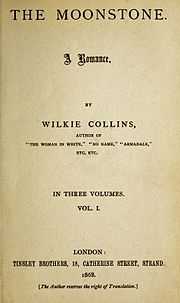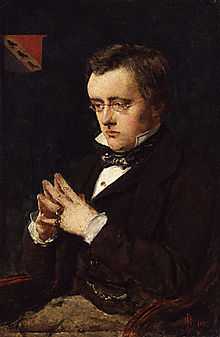The Moonstone
|
First edition title page | |
| Author | Wilkie Collins |
|---|---|
| Country | United Kingdom |
| Language | English |
| Genre | epistolary novel, mystery novel supernatural |
| Publisher | Tinsley Brothers |
Publication date | 1868 |
| Media type | |
| ISBN | N/A |
| Text | The Moonstone at Wikisource |
The Moonstone (1868) by Wilkie Collins is a 19th-century British epistolary novel, generally considered the first detective novel in the English language. The story was originally serialised in Charles Dickens' magazine All the Year Round. The Moonstone and The Woman in White are considered Wilkie Collins' best novels. Besides creating many of the ground rules of the detective novel, The Moonstone also reflected Collins' enlightened social attitudes in his treatment of the servants in the novel. Collins adapted The Moonstone for the stage in 1877, but the production was performed for only two months.
Etymology
The Moonstone of the title is a diamond (not to be confused with the semi-precious moonstone gem). It gained its name from its association with the Hindu god of the moon, Shiva. Originally set in the forehead of a sacred statue of the god at Somnath, and later at Benares, it was said to be protected by hereditary guardians on the orders of Vishnu, and to wax and wane in brilliance along with the light of the moon.
Plot outline
Rachel Verinder, a young English woman, inherits a large Indian diamond on her eighteenth birthday. It is a legacy from her uncle, a corrupt British army officer who served in India. The diamond is of great religious significance as well as being extremely valuable, and three Hindu priests have dedicated their lives to recovering it. The story incorporates elements of the legendary origins of the Hope Diamond (or perhaps the Orloff Diamond). Rachel's eighteenth birthday is celebrated with a large party, whose guests include her cousin Franklin Blake. She wears the Moonstone on her dress that evening for all to see, including some Indian jugglers who have called at the house. Later that night, the diamond is stolen from Rachel's bedroom, and a period of turmoil, unhappiness, misunderstandings and ill-luck ensues. Told by a series of narratives from some of the main characters, the complex plot traces the subsequent efforts to explain the theft, identify the thief, trace the stone and recover it.
Literary significance
The book is regarded by some as the precursor of the modern mystery novel and suspense novels. T. S. Eliot called it "the first, the longest, and the best of modern English detective novels in a genre invented by Collins and not by Poe",[1] and by Dorothy L. Sayers as "probably the very finest detective story ever written".[2] In "The Victorian Age in Literature" G. K. Chesterton calls it "Probably the best detective tale in the world." It was published in 1868, after Poe's mysteries "The Murders in the Rue Morgue" (1841), which introduced the famous locked-room paradigm; "The Mystery of Marie Rogêt" (1842); and "The Purloined Letter" (1845). The plot also shows some parallels with an earlier murder mystery story by the English novelist Sarah Burney, The Hermitage (1839): the return of a childhood companion, the sexual symbolism of defloration implied in the crime, and almost catatonic reactions of the heroine to it, for instance;[3] but The Moonstone introduces in novel form, as opposed to Poe's short story form, a number of elements that were to become classic attributes of the twentieth-century detective story:
- English country house robbery
- An "inside job"
- red herrings
- A celebrated, skilled, professional investigator
- Bungling local constabulary
- Detective enquiries
- Large number of false suspects
- The "least likely suspect"
- A rudimentary "locked room" mystery
- A reconstruction of the crime
- A final twist in the plot
Franklin Blake, the gifted amateur, is an early example of the gentleman detective. The highly competent Sergeant Cuff, the London policeman called in from Scotland Yard (whom Collins based on the real-life Inspector Jonathan Whicher who solved the Constance Kent murder),[4] is not a member of the gentry and is unable to break Rachel Verinder's reticence about what Cuff knows to be an inside job. The social difference between Collins' two detectives is nicely shown by their relationships with the Verinder family: Sergeant Cuff befriends Gabriel Betteredge, Lady Verinder's steward (chief servant), whereas Franklin Blake eventually marries Rachel, her daughter.
The Moonstone represents Collins's only complete reprisal of the popular "multi-narration" method that he had previously utilised to great effect in The Woman in White. The technique again works to Collins's credit: the sections by Gabriel Betteredge (steward to the Verinder household) and Miss Clack (a poor relative and religious crank) offer both humour and pathos through their contrast with the testimony of other narrators, at the same time as constructing and advancing the novel's plot.
One of the features that made The Moonstone such a success was the sensationalist depiction of opium addiction. Unbeknownst to his readership, Collins was writing from personal experience. In his later years, Collins grew severely addicted to laudanum and as a result suffered from paranoid delusions, the most notable being his conviction that he was constantly accompanied by a doppelganger he dubbed "Ghost Wilkie".
It was Collins's last great success, coming at the end of an extraordinarily productive period which saw four successive novels become best-sellers. After The Moonstone he wrote novels containing more overt social commentary, which did not achieve the same audience. A heavily fictionalised account of Collins' life while writing The Moonstone forms much of the plot of Dan Simmons' 2009 novel, Drood.
Although Moonstone is often seen as the first detective novel, Edgar Allan Poe's short story mysteries, The Murders in the Rue Morgue (1841) and The Purloined Letter (1845) were published before The Moonstone. Also a number of critics suggest that Charles Felix's (pseudonym for Charles Warren Adams) lesser known Notting Hill Mystery (1862–63) preceded The Moonstone by a number of years and first used techniques that would come to define the genre.[5][6]
Film, radio, and television adaptations
In 1934, the book was made into a critically acclaimed American film, The Moonstone by Monogram Pictures Corporation. Adapted to the screen by Adele S. Buffington, the film was directed by Reginald Barker and starred David Manners, Charles Irwin, and Phyllis Barry.
On 11 March 1945, "The Moonstone" was episode number 67 of the radio series, The Weird Circle.
On 16 November and 23 November of 1953, "The Moonstone",starring Peter Lawford, was broadcast in a 2-part episode of the radio drama "Suspense".
In 1959, the BBC adapted the novel into a television serial starring James Hayter. In 1972 it was remade in the United Kingdom, featuring Robin Ellis, and aired in the United States on PBS's Masterpiece Theatre. In 1996 it was remade again, also in the United Kingdom, for television by the BBC and Carlton Television in partnership with US station WGBH of Boston, Massachusetts, airing again on Masterpiece Theatre. It starred Greg Wise as Franklin Blake and Keeley Hawes as Rachel Verinder.
In 1974 a german version was shown http://www.imdb.com/title/tt0071011/?ref_=fn_al_tt_1.
In 2011 BBC Radio 4 serialised the story in four hour-long episodes in the Classic Serial slot.
The BBC has commissioned a new television adaptation of The Moonstone, that was set to be broadcast over Christmas 2012, but as of March 2013 had still yet to be shown. The adaptation will comprise three episodes, each of which will be one hour in duration.[7]
References
- ↑ David, Deirdre The Cambridge companion to the Victorian novel p179. Cambridge University Press, 2001.
- ↑ Hall, Sharon K (1979). Twentieth century literary criticism. p.531. University of Michigan
- ↑ Lorna J. Clarke: "Introduction", p. xxiv. In: Sarah Burney: The Romance of Private Life. The Hermitage (London: Pickering & Chatto, 2008. ISBN 1-85196-873-3).
- ↑ Karl, Frederick R (2002). "Introduction". The Moonstone. New York. p. 9. ISBN 0-451-52829-8.
- ↑ Paul Collins. "The Case of the First Mystery Novelist", in-print as "Before Hercule or Sherlock, There Was Ralph", New York Times Book Review, 7 January 2011
- ↑ Julian Symons (1972), Bloody Murder: From the Detective Story to the Crime Novel. pg.51: "...there is no doubt that the first detective novel, preceding Collins and Gaboriau, was The Notting Hill Mystery.
- ↑ "BBC Controller of Drama Ben Stephenson announces range of new commissions reflecting the unique strengths of BBC One drama". BBC Media Centre. 11 January 2012. Retrieved 12 January 2012.
External links
| Wikisource has original text related to this article: |
| ||||||||||||||||||||||||||||
| ||||||||||

